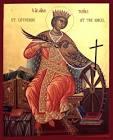
Feast day: 25 November
St Catherine of Alexandria is one of those saints whose existence is disputed, like Ss Ursula, Philomena and Barbara. She may have been confused with Dorothea of Alexandria or even the learned lady Hypatia, or she may be have been a composite of several virgin martyrs. She is important, however, because she was a very popular saint during the middle ages, being named as one of the Fourteen Helpers; she appears frequently in paintings and she was one of the three saints who inspired St Joan of Arc. She was removed from the calendar by Pope Paul VI and reinstated by John Paul II, out of respect for the Orthodox church, which venerates her, particularly in the great monastery of St Catherine of Sinai.
The earliest surviving account of Catherine’s life comes around six hundred years after her martyrdom, in the Menologium document compiled in 976 for the Emperor Basil II, although the alleged discovery of her relics was about 800, at Mount Sinai.
This is the legend of St Catherine. She was the daughter of the governor of Alexandria. She had a vision of the Virgin Mary and the Child Jesus and this converted her to Christianity. When persecutions began, she went to the emperor to rebuke him for his cruelty. He summoned fifty of the best pagan philosophers and orators to debate with her and refute her pro-Christian arguments but Catherine won the debate. Several of her adversaries were converted to Christianity and were put to death.
The Emperor then tried to marry her but she refused, saying that her only spouse was Christ. She did convert his wife, however, who was also put to death. The Emperor was enraged and threw her into prison where she was severely tortured. Angels tended to her wounds, she was fed daily by a dove from heaven and had visions of Christ who urged her to persist. When she emerged from her prison there was a bright light and a sweet smell of perfume.
Catherine was condemned to die on a spiked breaking wheel which fell apart when she touched it. This became her symbol. She was then beheaded. Angels carried her body to Mount Sinai where, later, the Emperor Justinian built St Catherine’s monastery; this is now a sacred site for Christianity, Islam and Judaism. It was renamed after Catherine when her relics were discovered at the foot of Mount Sinai.
She has said to have received a vision of the Child Jesus, who placed a ring on her finger in the presence of his mother as a sign that she was mystically married to him. This was symbolic of the soul’s union with God. Catherine of Siena would later have the same experience.
Catherine’s cult was widespread in medieval Europe and England where sixty two churches are dedicated to her and one hundred and seventy bells are named after her. The earliest English life was written in the thirteenth century and the first recorded miracle play was in her honour. On a lighter note the popular firework, the Catherine wheel, is named after the wheel which was supposed to execute her.
St Catherine of Alexandria, pray for us.